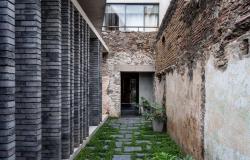Saturday, June 8, 2024, 01:02
Comment
Copy link
WhatsApp
Facebook
x
LinkedIn
Telegram
A sign informs that the work has been temporarily lent. Information that further denotes its absence. And not only because its more than three meters of oil painting filled the main wall and the room seems orphaned, but because it is one of those pieces that you must not miss when visiting the Museum of Malaga. In fact, it is the most emblematic of the collection. ‘And I had a heart’ (1890), by Enrique Simonet, has changed its temporary address and has moved to the Prado Museum, owner of this work deposited in Customs since the 1930s and which has claimed it for its great exhibition ‘Art and social transformations in Spain (1885-1910)’, which opened a few days ago.

The canvas ‘And I had a heart’, hanging in the temporary rooms of the Prado Museum.
Oscar Chamorro
The monumental canvas now hangs in one of the rooms of the rehabilitated Jerónimos building in the expansion of the Madrid art gallery, where it is exhibited accompanied by another piece from the Malaga collection, ‘The Vaccine’ (1911), by Vicente Borrás Abellá, which will also return to Malaga restored, since, before this exhibition, it has gone through the Prado workshops to recover its original tone.

The work ‘The Vaccine’, by Borrás Abella, is also exhibited in the Prado Museum.
Oscar Chamorro
Both oil paintings from the Museum of Malaga show the reflection in art of the social changes of the late 19th and early 20th centuries, particularly the interest of realist painting in scientific and medical themes. In the case of the popular canvas painted by Simonet, it was the result of his stay in Rome, where he arrived thanks to a scholarship from the San Fernando Academy in Madrid. The artist completed a daring and audacious piece from notes taken in the morgue, which had an impact due to the unusual autopsy scene that was applauded by many critics, although others did not know how to see the risk and rupture of the then young painter and arrived at it. to be labeled “repulsive.” In the end, the trend that thought that the canvas distilled poetry and beauty à la Edgar Allan Poe prevailed, becoming a symbol of the Museum of Malaga when it arrived on loan from the Museum of Modern Art (whose collection went to the Prado when it disappeared in the 70s). .

The autopsy scene recorded by Enrique Simonet had an impact in 1890.
Oscar Chamorro
The work of Enrique Simonet even starred in a controversy in 1998, when the Museum of Malaga had already been evicted from the Buenavista Palace for the rehabilitation of the building as the Picasso Museum and it was an art gallery without land, without a headquarters. The Prado then claimed the emblematic canvas of the forensic scene, along with five others deposited in the Fine Arts section of the Malaga institution, which caused numerous protests from cultural spheres and the suspicion of the Andalusian museum itself, so it finally gave up. of this demand.
The Prado Museum exhibition also rescues a photograph of the Los Angeles Asylum during a food distribution in 1904
Curiously, now that the state museum has recovered the work until September to display it in the exhibition ‘Art and social transformations in Spain (1885-1910)’ it has also rescued its canonical name, ‘An autopsy’, instead of the apocryphal designations ‘ Anatomy of the heart’ and, particularly, ‘And he had a heart’, as shown on the Malaga cartouches. As the director of the Customs Museum, María Morente, explains, Simonet opted for a descriptive title in line with that fashion of capturing scientific advances, but with the arrival of the work in Malaga in the 20th century, the new identification in a patriarchal key became popular, speculating that the deceased who stars in the painting is a prostitute and the doctor is surprised that she had a heart, hence the alternative and popular title. The influence of this piece on contemporary painting can be traced to different artists, among which Barbara Kruger’s work ‘No radio’ (1988) stands out, which is exhibited at the San Francisco Museum of Modern Art (USA).
Medicine and poverty
The other piece in the collection of the Museum of Malaga, ‘The Vaccine’ (1911), also addresses a medical theme with the tender scene immortalized by Borrás Abella of a doctor for whom a long line of babies with their mothers is waiting to go through the needle. A work that also shows the health advances of the time, with a consultation attended by everyone from bourgeois women to more humble families with their naked children. Both the latter and Simonet’s are exhibited very close to each other, since they are included in the exhibition section ‘Illness and Medicine’, where they share space with Picasso, Sorolla, Rusiñol and Jiménez Aranda.

1904 photograph of the Los Angeles Asylum, assisting hundreds of people.
National Heritage/El Prado
The temporary exhibition, which reaches 300 works on display including painting, sculpture and photography, also includes a revealing snapshot taken in 1904 at the Asilo de los Ángeles. Of an unknown author, this image belonging to the National Heritage archive and the Royal Collections is part of the ‘Poverty and ethnic and social marginalization’ block and reproduces hundreds of women and children (on the right and in the center of the painting) and some men (left) who pose with a face of resignation, while waiting for the distribution of food on May 1st. A scene full of sadness that gives an idea of the misery of that city at the turn of the century in which neither scarcity nor heart was lacking.





